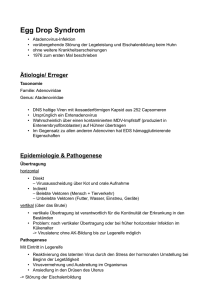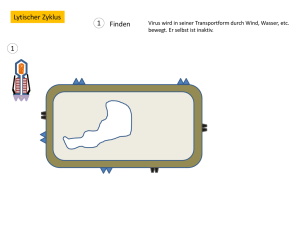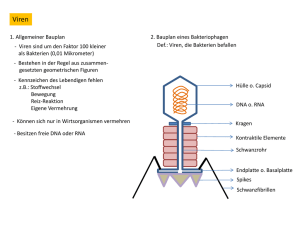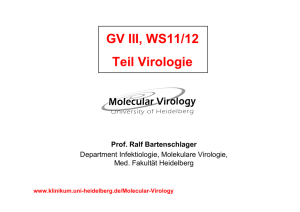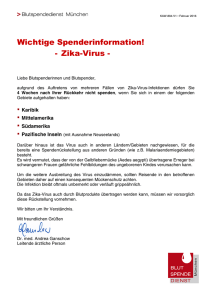Kriterien für die Einteilung von Vektoren
Werbung
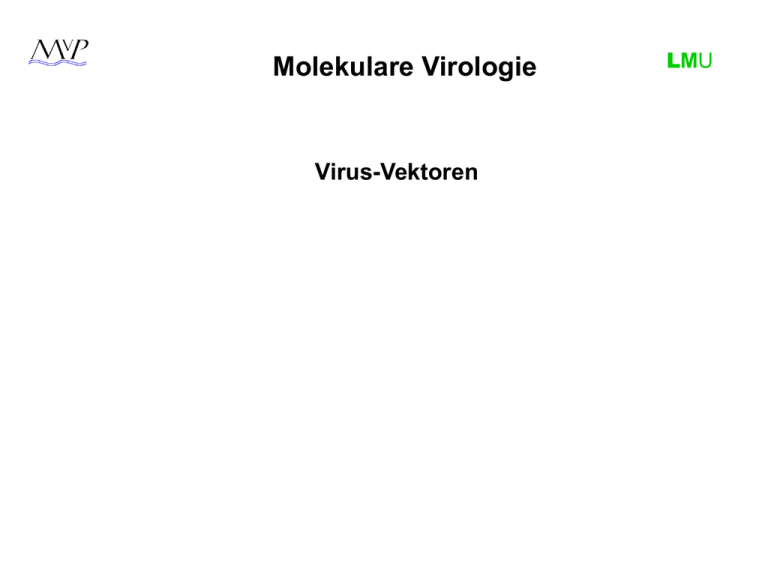
Molekulare Virologie Virus-Vektoren LMU (Virale) Vektoren -Systeme und Einsatzfelder RNA-/DNA-Vektoren im Vergleich http://www.nature.com/nrg/journal/v4/n5/fig_tab/nrg1066_F2.html Molekulare Virologie RNA-Vektoren LMU Virale RNA-Vektoren LMU a) RNA in Funktion einer m-RNA: Proteinexpression (Vakzine, toxisches Protein, therapeutisches Genprodukt, ...) b) RNA als unmittelbar wirkende Substanz: keine Translation (z.B.: Transfektion von Aptameren) keine Integration (Ausnahme HIV, ...) transiente Expression hohe Kurzzeitexpression hohe Virustiter viele Zelltypen Wirkort: meist Zytoplasma ?! Virale Vakzine Vektoren basierend auf RNA-Viren RNA - Inhibition ( ) famulok.chemie.uni-bonn.de/people/mayer/Vorlesung/RNA%20Biochemie%208.pdf - famulok.chemie.uni-bonn.de/people/mayer/Vorlesung/RNA%20Biochemie%208.pdf - Aptamere famulok.chemie.uni-bonn.de/people/mayer/Vorlesung/RNA%20Biochemie%208.pdf - famulok.chemie.uni-bonn.de/people/mayer/Vorlesung/RNA%20Biochemie%208.pdf - Ribozyme gene therapy involves the following steps: 1. Delivery of RNA strands engineered to function as ribozymes. 2. Specific binding of the ribozyme RNA to mRNA encoded by the mutated gene 3. Cleavage of the target mRNA, preventing it from being translated into a protein Antisense RNA http://learn.genetics.utah.edu/content/tech/genetherapy/gtapproaches / Antisense-RNA - Fomivirsen (Vitravene) Fomivirsen ist ein AntisenseOligonukleotid und ein Arzneistoff, welcher als Virostatikum zur Behandlung von Infektionen mit dem Cytomegalievirus (CMV) bei Immundefizienz, wie AIDS eingesetzt wird. Fomivirsen ist ein 21mer Antisense-RNA Phosphorthioat-Oligonukleotid (ISIS 2922)[1] mit einer komplementären Sequenz zur mRNA, der major immediate-early (MIE) transkriptionalen Einheit des humanen Cytomegalievirus (CMV). Durch die Bindung der aRNA an die komplementäre mRNA wird die Translation dieser viralen mRNA blockiert und damit die Genexpression der Proteine der IE2-Region (IE2), IE86 und IE55, verhindert.[2] Fomivirsen war das erste AntisenseOligonukleotid das von der FDA zugelassen wurde. The first FDA-approved antisense drug. Structure of the 21-mer phosphorothioate, fomivirsen (brand name Vitravene, illustration from [223]). The patient target group for this drug is rather small, and it was taken off the market by the manufacturer in 2002 due to poor sales famulok.chemie.uni-bonn.de/people/mayer/Vorlesung/RNA%20Biochemie%208.pdf - famulok.chemie.uni-bonn.de/people/mayer/Vorlesung/RNA%20Biochemie%208.pdf - famulok.chemie.uni-bonn.de/people/mayer/Vorlesung/RNA%20Biochemie%208.pdf - siRNA famulok.chemie.uni-bonn.de/people/mayer/Vorlesung/RNA%20Biochemie%208.pdf - RNA-Transfer in Zellen famulok.chemie.uni-bonn.de/people/mayer/Vorlesung/RNA%20Biochemie%208.pdf - famulok.chemie.uni-bonn.de/people/mayer/Vorlesung/RNA%20Biochemie%208.pdf - ss-RNA (+)-Vektoren Rabiesvirus http://www.bio.davidson.edu/courses/immunology/Students/spring2006/Jameson/rabies%20structure.bmp The neuroinvasiveness of the virus results from its ability to migrate to the central nervous system (CNS) through retrograde axonal transport and transynaptic spread. Rabies virus spreads from the postsynaptic site to the presynaptic site via receptor-mediated endocytosis. In retrograde axonal transport, the ribonucleoprotein complexes of the virus are carried by direct attachment to a dynein motor or by encapsulation in vessicles attached to a dynein motor. The rabies virus genome gsbs.utmb.edu/microbook/ch061.htm Neuronal tracing of rabies virus The construction of the RV full-length cDNA vector (pHEP5.0-CVSG) was described previously (Inoue et al., 2004). Three recombinant RV-vectors were newly generated for dual viral tracing by inserting transgenes: the LacZ gene which encodes for β-galactocidase (β-gal) or the gene for green fluorescent protein (GFP) variants, into the multiple insertion site of the virus vector genome (Figure 2). To create a vector which expresses either β-gal or the yellow fluorescent protein named Venus (Nagai et al., 2002), a PCR fragment of LacZ cDNA (Invitrogen, USA) and Venus cDNA containing the Sbf I site, open reading frame, and Sac II were amplified and inserted into the same site of pHEP5.0-CVSG, respectively. http://cms.frontiersin.org/content/10.3389/neuro.05/001.2009/html/fnana-03-001/images/article/image_n/fnana-03-001-g002.gif http://cms.frontiersin.org/content/10.3389/neuro.05/001.2009/html/fnana-03-001/fnana-03-001.html Interference studies of double-infected neuron cells To evaluate the ability of the rabies virus vectors to infect a cell in which an ongoing infection exists, two vectors expressing different reporter proteins, rHEP5.0-CVSG-β-gal and rHEP5.0-CVSG-Venus, were applied to the same culture dish at different time intervals. First, 300 μl of rHEP5.0-CVSG-Venus (1.0 × 107 focus-forming units (FFU)/ml) was applied. After a certain time delay (0 h, 2 h, 6 h, 12 h), 300 μl of rHEP5.0CVSG-β-gal (1.0 × 107 FFU/ml) was applied. Retroviral Vectors • Based on:– Murine leukaemia virus (MLV) – Lentiviruses such as HIV, SIV, FIV – Mouse mammary tumour virus (MMTV) – Foamy/spuma viruses Retroviral Genome R U5 Viral RNA U3 R gag pol env gag pol env Reverse Transcription Integration Proviral DNA LTR U3 R U5 LTR U3 R U5 Retroviral Vector Principle Retrovirus LTR ψ env pol gag LTR U3 R U5 Retroviral Vector LTR U3 R U5 ψ gene LTR U3 R U5 Packaging Construct U3 R U5 gag pol env Packaging Cells Retroviral Vector LTR ψ gene U3 R U5 gag pol LTR U3 R U5 env Recombinant Virus Safety features for replication incompetent vectors •ProCon Vectors • • Deletion of U3 of the 3’ LTR Insertion of Inducible/Tissue Specific Promoter TG U3 RU5 TG mRNA U3R U5 U3 RU5 Promoter R U5 TG • Replacement of Viral Promoter Promoter RU5 TG Promoter RU5 Mrochen et al., (1997) J.Mol.Med. 75, 820 Risks associated with Retroviruses • Insertional Integration Leading to – Gene disruption (tumour suppressor) – Gene activation (proto-oncogene) DNA (Virus) Vektoren Kriterien für die Einteilung von Vektoren: 1) Administration Nackte DNA Replikationsdefiziente Viren Replikationskompetente Viren Kriterien für die Einteilung von Vektoren: 1) Administration – nackte DNA Transfektion Physikalische Transfektionsmethoden 1) Nadel Injektion in Gewebe / Inhalation 2) Hydrodynamischer Gentransfer 3) Mikroinjektion in Nukleus 4) „Gene Gun“ Transfer 5) Elektroporation Kondensation Chemische Transfektionsmethoden Positive Ladung 1) Kalziumphosphat Co-Präzipitation (Membranfusion) 2) Kationische Polymere 3) Kationische Lipide („non-bilayer forming“) 4) Liposomen („bilayer forming“) Transfektionsmethoden mit „nuclear localization signals“ Geringe Effizienz des Gentransfers Einbringen von Vektoren in Zellen Transfektion - artifizielles Einbringen von Nukleinsäuren in eukaryotische Zellen - Kunstwort aus TRANSformation + InFEKTION - DNA-Aufnahme durch die Zelle in Form von Salz-Präzipitaten oder als membrangängige Micellen Calzium-Phosphat-Methode Liposomen-Methode www.rz.uni-karlsruhe.de/~dc29/zoologie2/vorlesungsmat/EB1/070207/Protein-Dateien/Protein.ppt Kriterien für die Einteilung von Vektoren: 1) Administration – Replikationsdefiziente Viren Transduktion Beibehaltung der Mechanismen der Ausgangsviren zur Infektion (Transduktion) von Zielzellen Dadurch: sehr hohe Effizienz des Gentransfers Zusammenbau in z.T. komplexen Produktionssystemen Häufig immunogen (humorale und zelluläre Immunantwort) Nicht-integrierende Vektoren sind nur „transient“ Kriterien für die Einteilung von Vektoren: 1) Administration – Replikationskompetente Viren Infektion Basieren auf attenuierten bzw. genetisch modifizierten replikationskompetenten Viren Anwendung (Studien) v.a. in der Therapie von Tumoren (onkolytische Viren) und in der DNA Vakzinierung Kriterien für die Einteilung von Vektoren: 2) Replikation Kein Mechanismus zur Replikation vorhanden Verlust des Vektors während der Zellteilungen ! transiente Expression eines Transgens Achtung: nicht mehr oder selten teilende Zellen !!! (Indirekte) Replikation nach Integration ins Wirtschromosom stabile Expression eines Transgens Mechanismen der episomalen Replikation vorhanden stabile Expression eines Transgens Kopienzahl des Vektors ? Zellzyklus (MCM2-7) abhängige Replikation - (mini chromosome maintenance) ? Plasmidreplicons: Nicht-virale Plasmidreplicons und künstliche Chromosomen: 1) Historisch: Vektoren für die Hefe 2) Vektoren für Säugetierzellen Virale Plasmidreplicons: 1) Das Simian Virus 40 (SV40) Plasmidreplicon 2) Das Papillomavirus (HPV / BPV) Plasmidreplicon 3) Das Epstein-Barr Virus (EBV) Plasmidreplicon 4) „Substituted“ EBV Plasmidreplicons Administration als „nackte“ (Plasmid-) DNA Virale Plasmidreplicons: Das Simian Virus 40 (SV40) 5300 bp Familie: Polyomaviren 40 nm großes, ikosaedrisches Kapsid Nicht umhüllt Zirkulares, doppelsträngiges DNA Genom (5300 bp) MCM 2-7 unabhängige Replikation (T-Antigen ist replikative Helikase) Virale Plasmidreplicons: Das SV40 („high copy number“) Plasmidreplicon ab 1976 Model für die Untersuchung: - der eukaryontischen DNA Replikation - der Chromatinstruktur (Nukleosomen) - der Genregulation („cis acting“ Enhancer) - des alternativen „splicing“ MCM 2-7 Abhängigkeit Nein Nukleäre Retention Kopienzahl Kopienzahl 100-1000 DNA Replikation SV40 ORI + T-Antigen Virale Plasmidreplicons: Das SV40 („high copy number“) Plasmidreplicon heute Anwendung in der Biotechnologie: - Plasmidvektoren mit SV40 ORI und Promoter in cis - Zellinien mit T-Antigen (293T, COS etc.) in trans Immortalisierung (Transformation) von primären Zellen via T-Antigen („libraries“ !) Das T-Antigen: - Bindung an SV40 ORI - MCM 2-7 unabhängige, replikative Helikase - Virales Onkoprotein (Inaktivierung von p53 und pRB) - Immunogene Eigenschaften Virale Plasmidreplicons: Papillomaviren (HPV / BPV) Familie: Papillomaviren 55 nm großes, ikosaedrisches Kapsid Nicht umhüllt Zirkulares, doppelsträngiges DNA Genom (7900 bp) MCM 2-7 unabhängige Replikation (E1 ist replikative Helikase) Virale Plasmidreplicons: Das BPV („intermediate copy number“) Plasmidreplicon 1980 piggy back Chromosom E2 E1 MCM 2-7 Abhängigkeit Nukleäre Retention Kopienzahl DNA Replikation Nein (E1 +) E2 – Chromsom (Kopienzahl) ~ 50 - 150 BPV ORI + E1 + E2 Virale Plasmidreplicons: Das Epstein-Barr Virus (EBV) 172 kbp ori P ori lyt IR: inverted repeat TR: terminal repeat U: unique region ori P: latenter (Plasmid) Ori ori lyt: lytischer ORI Familie: Herpesviren 160 nm großes, umhülltes Virus Ikosaedrisches Kapsid Doppelsträngiges DNA Genom (172 kbp): - Linear im Virion - Zirkular nach Rezirkularisierung im Zellkern MCM 2-7 abhängige latente Replikation (ori P) MCM 2-7 unabhängige lytische Replikation (ori lyt) ori lyt Virale Plasmidreplicons: Das EBV („low copy number“) Plasmidreplicon Latenz-ORI: ori P 1985 Nukleäre Retention EBNA1 FR 24 x Chromosom EBNA DS 4 x EBNA ORC / MCM 2-7 piggy back FR FR: family of repeats (24 x) DS: dyad symmetry element (4 x) DS EBNA1 ORC / MCM2-7 – Rekrutierung Replikation MCM 2-7 Abhängigkeit Ja Nukleäre Retention OriP (FR) + EBNA1 - Chromosom Kopienzahl ~10 DNA Replikation OriP (DS) + EBNA1 RNA-/DNA-Vektoren im Vergleich img.medscape.com/.../540/632/nf540632.tab1.gif LMU Fazit: RNA-/DNA-Viren: RNA-Viren: in der Regel transient (Ausnahme: Retro-/Lentiviren), z.T: onkolytisch eher geringe Verpackungskapazität DNA-Viren: z.T. transient oder persistierend z.T. onkolytisch in der Regel eher größere Verpackungskapazität wenn persistierend, dann Langzeitexpression
